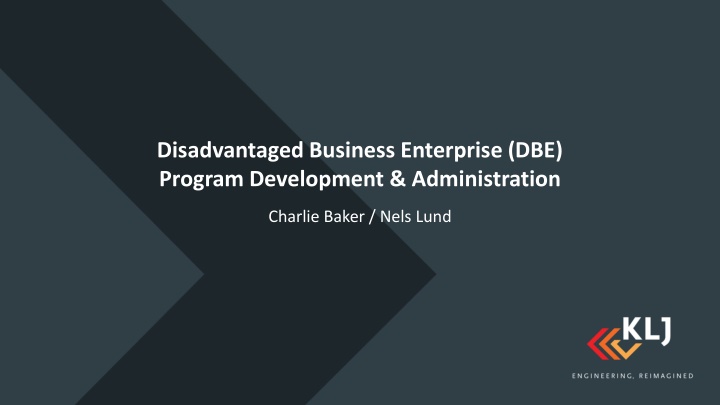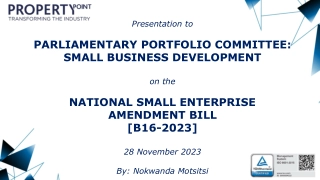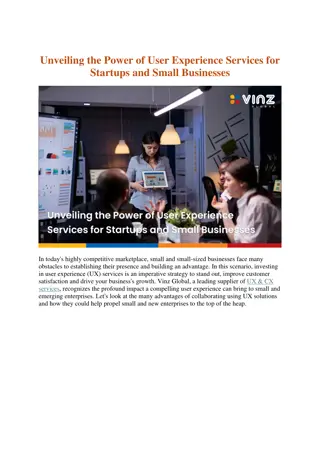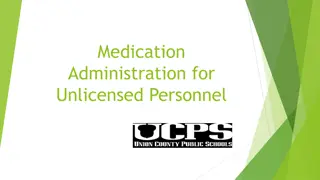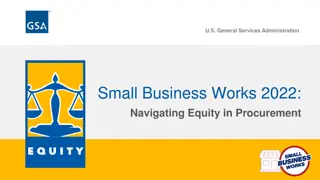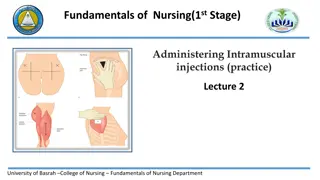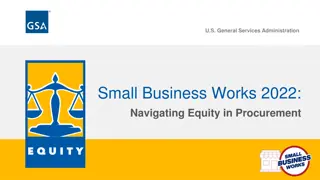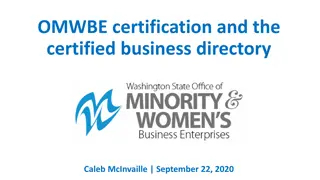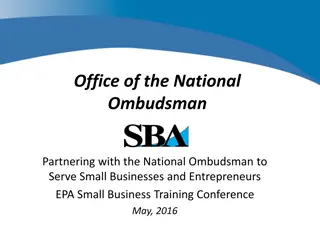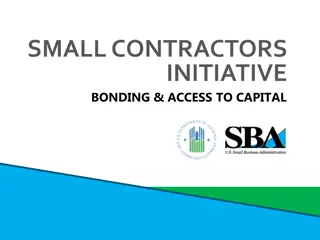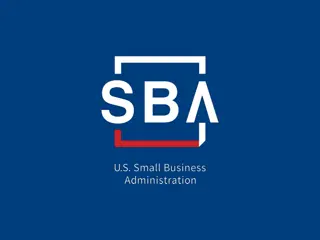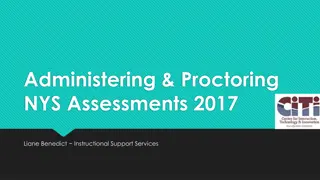Developing and Administering a DBE Program for Small Businesses
The Disadvantaged Business Enterprise (DBE) Program aims to support small businesses owned by socially and economically disadvantaged individuals. These individuals belong to various groups such as Black Americans, Hispanic Americans, Native Americans, Asian-Pacific Americans, Subcontinent Asian Americans, women, and others designated by the SBA. Recipients of DOT Federal Financial Assistance implement the DBE program, which includes creating DBE plans every three Federal Fiscal Years and reporting on DBE achievements annually.
Download Presentation

Please find below an Image/Link to download the presentation.
The content on the website is provided AS IS for your information and personal use only. It may not be sold, licensed, or shared on other websites without obtaining consent from the author.If you encounter any issues during the download, it is possible that the publisher has removed the file from their server.
You are allowed to download the files provided on this website for personal or commercial use, subject to the condition that they are used lawfully. All files are the property of their respective owners.
The content on the website is provided AS IS for your information and personal use only. It may not be sold, licensed, or shared on other websites without obtaining consent from the author.
E N D
Presentation Transcript
Disadvantaged Business Enterprise (DBE) Program Development & Administration Charlie Baker / Nels Lund
What is a DBE? At least 51% owned by one or more individuals who are both socially and economically disadvantaged; and Whose management and daily business operations are controlled by one or more of the socially or economically disadvantaged individuals who own it. Source: SDDOT website (dot.sd.gov)
Which groups are DBEs? Any individual in the following groups, members of which are rebuttably presumed to be socially and economically disadvantaged: Black Americans, which includes persons having origins in any of the Black racial groups of Africa; Hispanic Americans, which includes persons of Mexican, Puerto Rican, Cuban, Dominican, Central or South American, or other Spanish or Portuguese culture or origin, regardless of race; Native Americans, which includes persons who are enrolled members of a federally or State recognized Indian tribe, Alaska Natives, or Native Hawaiians; Asian-Pacific Americans, which includes persons whose origins are from Japan, China, Taiwan, Korea, Burma (Myanmar), Vietnam, Laos, Cambodia (Kampuchea), Thailand, Malaysia, Indonesia, the Philippines, Brunei, Samoa, Guam, the U.S. Trust Territories of the Pacific Islands (Republic of Palau), Republic of the Northern Marianas Islands, Samoa, Macao, Fiji, Tonga, Kirbati, Tuvalu, Nauru, Federated States of Micronesia, or Hong Kong; Subcontinent Asian Americans, which includes persons whose origins are from India, Pakistan, Bangladesh, Bhutan, the Maldives Islands, Nepal or Sri Lanka; Women; Any additional groups whose members are designated as socially and economically disadvantaged by the SBA, at such time as the SBA designation becomes effective. Source: SDDOT website (dot.sd.gov)
DBE Plan / Goal The Department of Transportation's (DOT) Disadvantaged Business Enterprise (DBE) program is implemented by recipients of DOT Federal Financial Assistance. Recipients are primarily state highway, transit, and airport agencies that receive funds subject to Title 49 Code of Federal Regulations part 26 (49 CFR 26). A similar program (49 CFR 23) for airport concession DBEs (ACDBE), is mandated by 49 U.S.C. 47107(e). The ACDBE program was originally enacted in 1987 and most recently amended in 2012. Source: FAA Civil Rights website (faa.gov)
DBE Plan / Goal Creation of DBE Plan / Goal (every 3 Federal Fiscal Years) Needed for FAA grant recipients awarding prime contracts for which the cumulative total value exceeds $250,000 in FAA Funds in a single federal fiscal year Due August 1 Ongoing DBE (Achievement) Reporting (annual) Due December 1 (after end of Federal Fiscal Year Oct. 1-Sept. 30)
When to Start DBE Plan / Goal? When updating the airport CIP (think of the next 3 years of projects) When scoping a project (typically this service is included in engineering contract) Prior to advertising a project for bid Goal needs to be approved and included in the bid package
DBE Goals and Project Specific DBE Goals 49 CRF (Code of Federal Regulations) Part 26 DBE Program To ensure non-discrimination of award / administration of DOT-assisted contracts To create a level playing field for DBE competition Paraphrased from: https://www.ecfr.gov/current/title-49/subtitle-A/part-26 Disadvantaged Business Enterprises. (Portion copied directly from an AIP grant agreement) The sponsor shall not discriminate on the basis of race, color, national origin or sex in the award and performance of any DOT-assisted contract covered by 49 CFR Part 26, or in the award and performance of any concession activity contract covered by 49 CFR Part 23. In addition, the sponsor shall not discriminate on the basis of race, color, national origin or sex in the administration of its DBE and ACDBE programs or the requirements of 49 CFR Parts 23 and 26.
Finished Product DBE Plan / Goal Goal is advertised in Local Newspaper and within SDDOT DBE Newsletter KLJ holds public comment meeting after advertising goal Governing board votes to approve and it is signed by Sponsor About 55-page document with airport- specific and project-specific information with Goal uploaded to FAA Civil Rights Connect
DBE (Achievement) Reporting - What is our goal?* To report: the contracts awarded to DBE s / non-DBE s and their DBE classification (by race/gender); ongoing grant reimbursement amounts including how much paid to DBE s (also ensures non-DBE s are being paid); final grant reimbursement amounts. For the previous (just ended) FAA Fiscal Year (Oct. 1- Sept. 30) *Due December 1 for all Airports
DBE Reporting End Goal The data from this spreadsheet entered on the Civil Rights Connect website for the Airport
Other Notes DBE Plan Responsiveness vs. Responsibility Responsive = turning in documents with the bid Responsibility = turning in documents within 5 days of the bid opening Race Conscious (RC) vs. Race Neutral (RN) If making a Contract Goal it is typically Race Conscious DBE Reporting No reporting needed if the cumulative total of grants is under $250,000 within the fiscal year. CARES/CRRSA/ARPA do not need to be reported unless the grant was used for a development project with established goals / contracts.
DBE Checks During Bidding DBE Form A DBEs Used / Not Used on Project DBE Form B List of ALL businesses providing quotes DBE Form C Confirmation DBEs Used on Form A will perform the work DBE Utilization DBE Utilization Calculation for Project and Percentage Achieved / Committed To Good Faith Efforts Used if Contractor Did Not Achieve the Project Goal NOTE: DBEs Used must be registered as a DBE in state the work is to be performed in.
When do you use the DBE Program? When things go wrong! Did not provide adequate Good Faith Efforts with bid Sponsor s role Administrative reconsideration process Bid protest Nonperforming subcontractors (replacement) Prime contractor not paying subcontractors on time (prompt payment) What do you do? Read and follow your plan.
